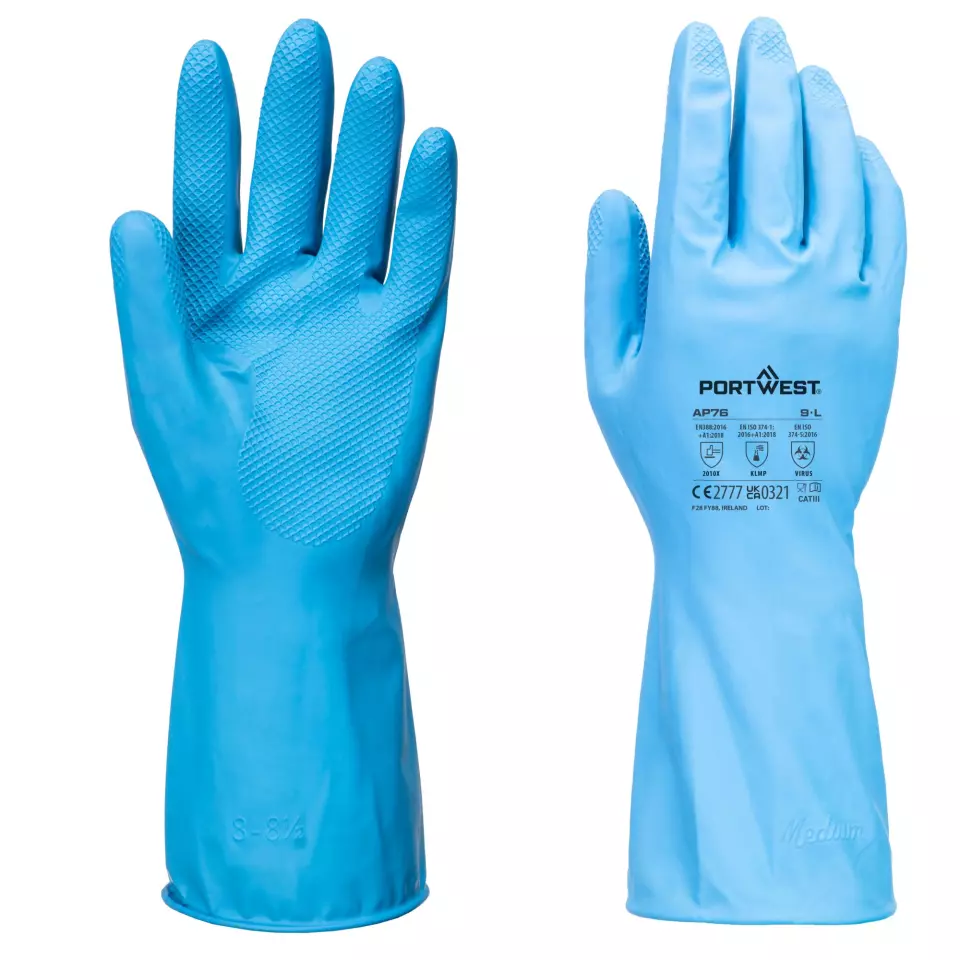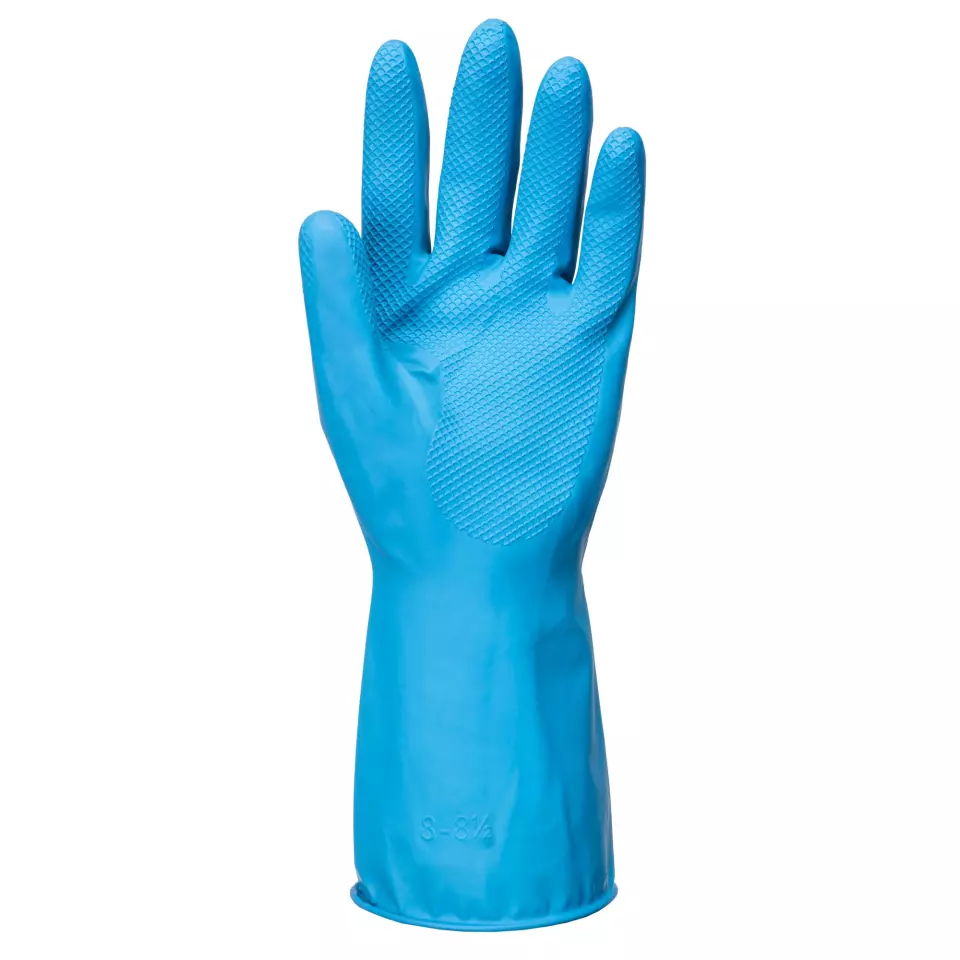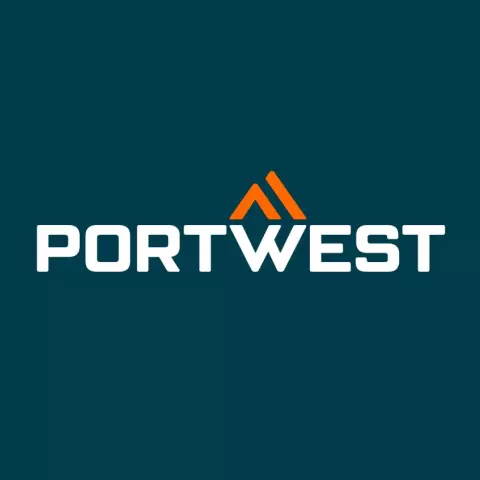Portwest FD Chemical B Latex Light Gauntlet, Blue
Portwest
visit storeProduct description
Food-grade latex gauntlets designed for food processing applications requiring safety, hygiene, and comfort. Manufactured from genuine natural rubber with cotton flock lining, these gauntlets provide excellent chemical resistance and extend to the forearm for complete coverage. The gauntlets are approved for safe food handling and comply with food safety legislation requirements.
Product Features:
- Gauntlet style extending to forearm for complete coverage
- Cotton flock lining for comfort and perspiration absorption
- Food-grade latex construction
- Resistant to greases, animal fats and oils
- Approved for safe food handling
Technical Details:
- Material composition: Genuine natural rubber with cotton flock lining
- Chemical resistant construction
- CE certified and UKCA marked
- Dexterity rating: Level 5
- Notified body: SATRA Technology Europe Ltd (2777/12647-03/E04-01)
Recommended Applications:
- Food processing plants
- Food handling operations
- Applications requiring chemical resistance to greases and oils
Standards:
- EN ISO 21420:2020
- EN 388:2016 + A1:2018 (2010X)
- EN ISO 374-1 (KLMP)
- EN ISO 374-4:2016
- EN ISO 374-5:2016 Virus and Micro Organisms
- EN 13130-1:2004
The inner lining or coating that affects comfort, grip, insulation, and protection against chemicals or allergens.
Determines visibility, safety compliance, and how well dirt and wear are concealed during use in different work environments.
Measures how far up the arm the glove extends, determining the area of protection from fingertip to cuff end for different safety requirements.
Determines how the glove secures around the wrist, affecting fit, protection from debris, and ease of putting gloves on and taking them off.
Full finger coverage offers complete protection and warmth, keeping your hands safe and comfortable.
Multi-purpose design offers versatile protection and comfort, ready for a wide range of tasks.
- Chemical Resistance
- Antimicrobial Protection
- Hand Protection
Request a free sample
Test first and buy later. Visit any product page to request your free sample.
Standards and labels
Test results
General Requirements GuideEN ISO 21420:2020 is a standard that outlines general requirements and guidelines for protective gloves, aiming to ensure their quality, performance, and suitability for various applications. When a product meets the requirements outlined in the General Requirements section of EN ISO 21420:2020, it signifies that the gloves comply with fundamental quality and performance criteria, including factors such as size, fit, ergonomics, and dexterity. The practical implications of this compliance are significant, as it assures users of the gloves' basic functionality and suitability for general hand protection purposes across a range of industries and applications. The test method involves evaluating various aspects of the gloves, including dimensions, construction, materials, and labeling, to ensure conformity with the specified requirements. Compliance with these general requirements enhances user confidence in the protective gloves' reliability and effectiveness, promoting workplace safety and facilitating compliance with regulatory standards.
EN 374-4:2013 is a European standard for gloves that protect against microorganisms. It sets rules for how the gloves should protect against microorganisms and how to test if they meet the standards. Gloves that pass the tests can have a label that says they meet the standard. The test results can be pass or fail for each test that checks the gloves resistance to microorganisms.
Test results
Degradation TestedThe standard EN 374-4:2013 pertains to the determination of degradation by chemicals for protective gloves. Degradation is assessed based on the change in physical properties of the glove material after contact with a chemical. Specifically, a result indicating degradation provides a measure of the glove's deterioration in terms of features like tensile strength and elongation when exposed to specific chemicals, gauged through physical tests such as elongation and tensile tests. The test method involves exposing the glove material to the chemical over a determined period, followed by mechanical testing to compare the pre and post-exposure properties. This result is crucial in determining the glove's suitability for use with specific chemicals, as degradation can significantly reduce its protective effectiveness, potentially endangering the user. Hence, understanding and adhering to this standard helps in the selection of appropriate protective gloves for specific chemical exposure scenarios, ensuring user safety and compliance with health and safety regulations.
EN 374-1:2003 is a European standard that specifies the performance requirements and test methods for chemical protective gloves. It defines the minimum requirements for gloves to protect against chemicals and microorganisms. The standard includes test methods for permeation resistance, degradation, and penetration. Possible test results include pass/fail for each requirement.
Test results
Performance Requirements Type AEN 374-1:2003 sets performance requirements for gloves to provide protection against chemicals. Type A indicates that the gloves meet high resistance standards for permeation by a range of chemicals. These gloves are tested against a broader spectrum of chemicals and offer reliable protection for applications involving frequent contact with chemicals, suitable for use in environments like chemical processing or where a variety of hazardous substances are handled.
EN 374-5:2016 is a European standard for gloves that protect against microorganisms, specifically gloves that are used for medical and dental procedures. It sets rules for how the gloves should protect against microorganisms and how to test if they meet the standards. Gloves that pass the tests can have a label that says they meet the standard. The test results can be pass or fail for each test that checks the gloves resistance to microorganisms.
Test results
Micro-organisms VirusEN 374-5:2016 is a standard that outlines the requirements and testing methods for protective gloves designed to protect against viruses. The designation 'Virus' indicates that the gloves have passed specific tests confirming their barrier effectiveness against viruses. These tests involve assessing the glove material's resistance to penetration by blood-borne pathogens and other virus-containing fluids, using a bacteriophage as a surrogate virus due to its small size and resistance. Gloves that meet this standard are vital in healthcare settings, laboratories, and any environment where there is a risk of exposure to viral infections. They are crucial for preventing the transmission of diseases, ensuring that workers are protected when handling potentially infectious materials, thus enhancing safety and health protocols in workplaces with biological hazards.
Micro-organisms Bacteria & FungiEN 374-5:2016 specifies the requirements and test methods for protective gloves intended to protect against bacteria and fungi. The designation 'Bacteria & Fungi' indicates that the gloves have been tested and verified to provide effective barrier protection against microbial agents. The testing involves evaluating the glove's material and seams for their impermeability to microorganisms under conditions that simulate real-world use, ensuring no penetration occurs through the glove material or at the seams. Gloves certified under this standard are crucial for use in environments such as healthcare, laboratory settings, and any applications where preventing the transmission of infectious agents is essential. They help ensure the safety and hygiene of workers by providing reliable protection against the risks of bacterial and fungal contamination.
EN 388:2016 is a European standard for measuring the performance of protective gloves against mechanical risks (abrasion, cut, tear, and puncture). The standard includes test methods and performance requirements for gloves to be considered compliant. Test results are reported using a series of four numbers, each representing the performance level achieved in one of the tests.
Test results
Puncture Resistance Level 0EN 388:2016 specifies safety glove standards, including puncture resistance. The test result Level 0 in puncture resistance indicates that the product does not meet the minimal requirements set by the standard for protecting against punctures. The test method used involves using a standardized stylus with a specified force applied to the glove material. This is measured by the amount of force needed before the stylus punctures through the glove material. A Level 0 result signifies that the glove failed to provide any standardized level of protection during the testing procedure, which means it is not suitable for environments where puncture resistance is required for safety purposes .
Cut Resistance, Coup Test Level 0The EN 388:2016 standard specifies requirements and test methods for protective gloves in relation to physical and mechanical aggressions due to abrasion, blade cut, tear, puncture, and impact resistance. A Cut Resistance Level 0 result in this standard implies that the protective gloves under assessment offer very minimal to no protection against cutting hazards. The Coup Test, utilized to determine this result, involves rotating a circular blade under constant pressure against the glove material until it is cut through. This test specifically assesses how well glove materials can withstand cutting forces from a sharp, circular blade. For procurement professionals, this result indicates that gloves with a Cut Resistance Level 0 are unsuitable for environments where there is a risk of hand injuries from sharp objects as they provide the lowest level of cut resistance under EN 388:2016.
Abrasion Resistance Level 2EN 388:2016 is an updated European standard that specifies criteria for testing gloves to protect against mechanical risks, including abrasion, cuts, tears, and puncture. The Abrasion Resistance Level 2 classification within this standard indicates a moderate level of protection against wear from rough materials. The abrasion resistance test involves subjecting the glove material to repeated cycles of sandpaper under pressure until the material wears through. Level 2 abrasion resistance means the gloves can withstand between 500 to 1999 cycles before being penetrated. This level of protection is suitable for tasks that involve handling or coming into contact with abrasive materials but not at an extreme or heavy-duty level. Gloves with Level 2 abrasion resistance are well-suited for general handling tasks, offering durability and protection to extend the life of the glove while maintaining good dexterity and comfort.
Tear Resistance Level 1EN 388:2016 is a European standard that outlines the testing requirements for gloves to determine their level of protection against mechanical hazards, including tear resistance. The Tear Resistance Level 1 classification signifies that the gloves offer basic protection against tearing. The test method involves applying a force to a sample of the glove material to tear it, and the force measured reflects the glove's ability to resist tearing. Level 1 tear resistance means the gloves can withstand a force of between 10 to 25 Newtons before tearing. This basic level of protection is suitable for tasks where there is a minimal risk of tearing due to light manual handling or where gloves are used to prevent scratches or minor abrasions. Gloves with Level 1 tear resistance are appropriate for general activities that do not involve handling sharp or jagged materials.
Cut Resistance, ISO 13997 Level XThe standard EN 388:2016, specifically its segment referring to ISO 13997 test, is designed to assess the cut resistance of materials used in protective gloves. A result denoted as 'Level X' means that test is not performed and the cut resistance of the product cannot be guaranteed.
CE Marking is a label that shows a product meets certain safety and environmental standards set by the European Union. To get the CE Marking, a company must test and certify their product meets these standards. CE Marking is required for many products sold in the EU, including electronics, machinery, toys and medical devices. It helps ensure that products are safe for consumers and the environment, and allows for easy trade within the EU.
Food safe refers to the safety of food products that are used or consumed by people. In Europe, food safety is regulated by the European Union (EU) and the European Food Safety Authority (EFSA). These organizations set standards and requirements for food products to ensure they are safe to eat. To be considered "food safe" in Europe, a product must meet these standards and be free of harmful substances. This includes being free of harmful bacteria, pesticides, and other contaminants. Food products that do not meet these standards cannot be sold or used in the EU.
PPE stands for "personal protective equipment." PPE Category 3 refers to equipment that is complex and provide the highest level of protection such as powered respirators, SCBA, and full body suits. In Europe, PPE Category 3 must meet certain safety standards set by the European Union, which means that it must be designed and manufactured to protect the user without causing harm. Companies that make or sell PPE must prove that it meets these standards. They also must have a quality management system in place, have to be audited regularly by a notified body and have to have a technical documentation.
Portwest delivery terms
Free delivery when you order more than 300,00 € from Portwest
Supplier shipping fee 4,92 €
Brand minimum 20,00 €
10,02 €
Price per 12 pairs
0,83 € / pair
Shipping fee is 4,92 € for orders under 300,00 €
A package contains 12 pairs
Need larger quantities?
Other products you may like
Recently viewed
Need help?
Get help from our experts
Other products you may like
Similar products you may like
Autonomous sourcing platform
The most efficient way to source and order supplies for your operations
Sourcing
Ordering
List products you’re looking for and we’ll find the best products and prices for you – all for free.
Need help?
Get help from our experts




